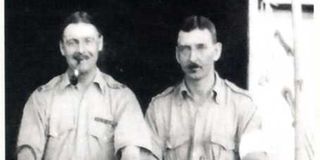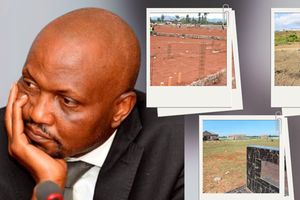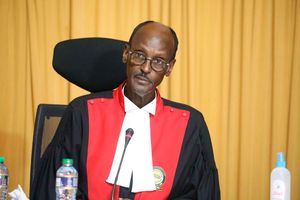
Kisumu hospital in 1918.
|Premium
How the Spanish flu spread in Kenya and lessons we can learn
The Spanish flu ranks as the worst ever pandemic in history. It hit the world in three waves between 1918 and 1920, infecting about half a billion people and killing between 50 and 100 million.
In eastern Africa, it is believed to have claimed the lives of between two and five per cent of the population in every country. Using today’s Kenyan population of 47 million, this would have been one million to 2.35 million deaths!
***
Spanish flu symptoms – respiratory difficulties, dry cough and high fever – were first detected in the United States, then in France and Belgium. It took a turn for the worse when it hit Spain and killed by the thousands, hence the name Spanish flu.
The disease was first detected in Kenya in 1918 in Mombasa. The town was immediately placed on lockdown, a measure that succeeded in temporarily halting the spread of the virus to other parts of the country.
However, complacency soon sneaked in and everybody let down their guard. This was fuelled by need to quickly rebuild the economy, which had suffered greatly from effects of the World War I, which ended the same year the disease struck.
Reached Nairobi
With containment measures eased, the disease reached Nairobi very fast, and people there died in their hundreds. It was clear the disease would soon be all over the country – and with devastating consequences. But two doctors in Kisumu were determined that the disease should not get to the lakeside town. Unfortunately, they did not gain much success.
The story is told in a book titled On Call in Africa, written by one of them, Dr Norman Jewell, who was the medical officer in charge at the Kisumu hospital.

Dr Norman Jewell with a colleague outside Kisumu hospital.
He writes: “At this time Kisumu was still free of the infection and I was alarmed when I heard that a number of police officers from the town were to travel to Nairobi to participate in a ceremony for presentation of medals. My protests and advice that every effort should be made to isolate Kisumu as much as possible were to no avail. When the police officers returned they, together with other travelers from Nairobi, were ordered into a special camp that had been set up on the outskirts of Kisumu to act as a quarantine station until the incubation period had passed. All of the passengers from the train they traveled in were directed to the camp with one exception - an Indian who ran off and disappeared into the Indian bazaar near the railway station.
“As soon as I learnt about it, I met the leaders of the Indian community and asked for their cooperation in finding the missing traveler. There were plenty of assurances that he was not in the bazaar and also that if he was found he would be handed over for quarantine. It became apparent that my pleas and attempts to persuade the Indian leaders of the seriousness of the situation were unsuccessful.
Beyond control
“Within two days, cases of the influenza began to appear. By the end of the week it was obvious that the disease was beyond our control, as residents from every community (European, Indian, and African) were taken ill in masses. On the second day, two assistant surgeons at the hospital were hit by the infection. With the aid of the hospital dispenser, Mr Gibb, I cleared all the beds from the hospital wards and laid mattresses on the floor to make as much accommodation available as possible.
“It was obvious that I would be unable to cope with the situation and I sent an urgent letter by boat to an old medical friend, Dr Peter Clearkin, who was involved in a medical survey for the government on an island at the mouth of the Kavirondo Gulf. My letter got to him one morning as he sat in front of his tent deep in thought. In it I told him the epidemic had struck the town; all Europeans had been attacked; the bank manager was dead, and the African and Indian populations were in even worse situation.
“The hospital was overcrowded and there were many deaths. I also briefed him about situation in the whole country, from the coast to the great lake.
Labour division
“We arranged a division of labour: I would look after the Europeans and Indians as he took charge of the hospital and the care of African patients. Two teams of stretcher bearers patrolled the roads and streets to bring the weak and feeble to hospital and take the dead to the mortuary”.
Dr Jewell continues the story: “I was able to undertake a post-mortem on one of the earliest fatal cases and found a pneumonic patch over the front of the chest corresponding to the clinical symptoms of pneumonia about the sternal area. This endorsed our suspicions that we were dealing with an epidemic type of pneumonia. The hospital dispenser, Mr Gibb, was a tower of strength in his dealings with the Africans.
“Speaking both Swahili and Luo, as well as being a preacher in the African church, he had the confidence of many of the African patients and did not spare himself in working day and night, making up the medicines and tending the sick. His work with the Africans became his whole life in later years when he was ordained as a clergyman and returned to the area. Others did what they could. ‘Bwana Pumps’ (he got the name as he was always pumping his bicycle on outreach to the victims of the pandemic), and who had ‘learned’ his medicine as office boy and sweeper before he ran a dispensary in South Nyanza region of Kenya, played the role of dispensing quinine and other medication throughout the period of the epidemic.
Deaths increased
“As the death toll mounted, those who died were taken from the hospital wards and the health office was notified to undertake burial. The situation, however, got completely out of hand and there were not enough fit men left to undertake all the burials. The Indian bazaar was in a terrible state. The Indians seemed more susceptible to the disease than either Europeans or Africans.
“In one small room I discovered 11 people lying on the floor all seriously ill and dying. This time when I called the leaders of the Indian community together, they were more responsive and quickly organised food and fruit supplies for the sick, as well as teams of workers to provide as much assistance as possible. My colleague and I quickly fell into an organised routine, starting our rounds about six o’clock in the morning after a quick breakfast and then meeting again at six o’clock in the evening for our next meal of the day, and the opportunity to exchange views on the seriousness of the situation.
Suicidal tendencies
“One alarming side-effect of the disease was the advent of suicidal tendencies. This was brought home forcefully one evening as we met for our evening meal. A small boy arrived to announce that the Indian hospital dispenser who had caught the disease had killed himself. The boy said ‘Babu’ who had employed him as a servant, had climbed onto a large water-tank beside his house and dipped himself inside. It was an obvious case. We went to club where the police superintendent could be and found him buying drinks to everyone. End to World War 1 had just been declared and they were obviously in mood of celebration. Drinks were thrust into our hands as everyone shouted: ‘The war is over!’
“But our (the two doctors) mental and physical state was such that we could not have cared less. One war – the shooting one – had ended, but another and more deadly – the Spanish flu – came knocking with fury! The news of ‘Babu’ suicide had an immediate sobering effect on the police superintendent who departed to carry out his investigation while we continued our rounds to help victims of the influenza.
***
“Reports from the region told of many deaths. As we were the only two doctors in Kavirondo Province (the name of what became Nyanza province in independent Kenya), a region the size of Wales in the UK, and with a population of approximately half a million, we were handicapped by lack of means of communication. But as soon as the epidemic in Kavirondo (Nyanza) began to subside, we were able to pay attention to SoS (save-our-souls) calls from the neighbouring regions”.
The author concludes: “Gradually the influenza disappeared and life in Kisumu returned to normal. My own health, which had not fully recovered from my experiences in the army during the war, again suffered severely with the demands on my services during the flu epidemic. My colleague insisted that he would stay in Kisumu while I took ten days leave with my family on a trip around the lake”.
***
We can defeat the virus. World Health Organization findings say the Spanish flu was finally conquered, and so will Covid-19, when individuals, institutions, and nations, make it their individual and collective responsibility to defeat the pandemic even as we balance on other demands for live and survival.
Personally, my family and I have worked on a plan to help us keep the killer virus at a bay. As for the institution relating to my career, I am happy to report that the Media Council of Kenya, the independent national statutory body established by law to regulate the Kenya media and protect its freedom, has rolled out a project to encourage journalists on all platforms – print, digital, and virtual – to sustain and intensify dissemination of information on how to defeat Covid-19.
What are you, as an individual, and your institution where applicable, doing to keep the defeat-coronavirus flame burning?





